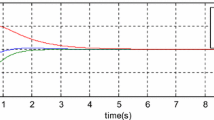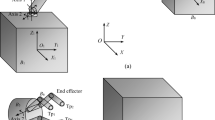Abstract
Collision of two objects is an inevitable physical phenomenon in the on-orbit service, such as docking, detumbling, and capturing. Preventing the separation of two objects and controlling their contact force after a collision are the keys to successfully executing these on-orbit tasks, particularly when the above-noted tasks involve a noncooperative object. This paper investigates the collision control problem in the on-orbit service in detail. Firstly, we have performed a rigorous analytical study of the damping control method given in our previous work, which can prolong the contact duration after a collision of two objects and has been validated through simulation experiments. Our theoretical analysis proves that the damping control method can successfully extend the contact duration by applying an external force to a collision system, whose functions are to modify the equilibrium position and the damping of the collision system. The external force is also referred to as the damping control force. In addition, inspired by the analysis result, this study has further proposed a new collision control method, also referred to as the resistance control method. Unlike the damping control force that be time-varying, the resistance control force is substantially constant. By adjusting the resistance control force and the initial relative velocity of a collision of two objects, the separation of two objects can be prevented, and their contact force can be controlled and maintained. Moreover, our theoretical analysis and simulation results have both demonstrated the effectiveness of this novel resistance control method over various scenarios.

















Similar content being viewed by others
Data availability
The datasets analyzed during the current study are available from the corresponding author on reasonable request.
References
Li, S., She, Y.: Recent advances in contact dynamics and post-capture control for combined spacecraft. Prog. Aerosp. Sci. 120, 100678 (2021)
Huang, W., He, D., Li, Y., Zhang, D., Zou, H., Liu, H., Yang, W., Qin, L., Fei, Q.: Nonlinear dynamic modeling of a tether-net system for space debris capture. Nonlinear Dyn. (2022). https://doi.org/10.1007/s11071-022-07718-7
Dai, H., Chen, H., Yue, X.: Dynamic analysis of detumbling a rotating satellite using flexible deceleration rod. Nonlinear Dyn. 108, 3331–3345 (2022)
Lee, S.H., Yi, B.J., Kim, S.H., Kwak, Y.K.: Modeling and analysis on the internal impact of a Stewart platform utilized for spacecraft docking. Adv. Robot. 15, 763–777 (2001)
Dai, H., Jing, X., Sun, C., Wang, Y., Yue, X.: Accurate modeling and analysis of a bio-inspired isolation system: with application to on-orbit capture. Mech. Syst. Signal Process. 109, 111–133 (2018)
Liu, Y.-Q., Yu, Z.-W., Liu, X.-F., Cai, G.-P.: Active detumbling technology for high dynamic non-cooperative space targets. Multibody Syst. Dyn. 47, 21–41 (2019)
Branz, F., Olivieri, L., Sansone, F., Francesconi, A.: Miniature docking mechanism for CubeSats. Acta Astronaut. 176, 510–519 (2020)
Chu, M., Zhang, X., Xu, S., Yu, X., Wang, D.: Modeling and stabilization control for space-borne series-wound capturing mechanism with multi-stage damping. Mech. Syst. Signal Process. 145, 106973 (2020)
Dai, H., Cao, X., Jing, X., Wang, X., Yue, X.: Bio-inspired anti-impact manipulator for capturing non-cooperative spacecraft: theory and experiment. Mech. Syst. Signal Process. 142, 106785 (2020)
Yoshida, K., Nakanishi, H., Ueno, H., Inaba, N., Nishimaki, T., Oda, M.: Dynamics, control and impedance matching for robotic capture of a non-cooperative satellite. Adv. Robot. 18, 175–198 (2004)
Nakanishi, H., Yoshida, K.: Impedance control for free-flying space robots -basic equations and applications. In: 2006 IEEE/RSJ International Conference on Intelligent Robots and Systems (IROS), pp. 3137–3142. IEEE (2006)
Uyama, N., Hirano, D., Nakanishi, H., Nagaoka, K., Yoshida, K.: Impedance-based contact control of a free-flying space robot with respect to coefficient of restitution. In: 2011 IEEE/SICE International Symposium on System Integration (SII), pp. 1196–1201. IEEE, Kyoto (2011)
Uyama, N., Nakanishi, H., Nagaoka, K., Yoshida, K.: Impedance-based contact control of a free-flying space robot with a compliant wrist for non-cooperative satellite capture. In: IEEE International Conference on Intelligent Robots and Systems, pp. 4477–4482. IEEE (2012)
Liu, X.F., Cai, G.P., Wang, M.M., Chen, W.J.: Contact control for grasping a non-cooperative satellite by a space robot. Multibody Syst. Dyn. 50, 119–141 (2020)
Liu, X.-F., Zhang, X.-Y., Cai, G.-P., Wang, M.-M.: A collision control strategy for detumbling a non-cooperative spacecraft by a robotic arm. Multibody Syst. Dyn. 53, 225–255 (2021)
Stolfi, A., Gasbarri, P., Sabatini, M.: A parametric analysis of a controlled deployable space manipulator for capturing a non-cooperative flexible satellite. Acta Astronaut. 148, 317–326 (2018)
Flores-Abad, A., Garcia Teran, M.A., Ponce, I.U., Nandayapa, M.: Compliant force sensor-less capture of an object in orbit. IEEE Trans. Aerosp. Electron. Syst. 57, 497–505 (2021)
Mitros, Z., Rekleitis, G., Patsiaouras, I., Papadopoulos, E.: Impedance control design for on-orbit docking using an analytical and experimental approach. In: 2017 25th Mediterranean Conference on Control and Automation (MED), pp. 1244–1249. IEEE (2017)
Mou, F., Wu, S., Xiao, X., Zhang, T., Ma, O.: Control of a space manipulator capturing a rotating object in the three-dimensional space. In: 15th International Conference on Ubiquitous Robots (UR), pp. 763–768. IEEE (2018)
Wu, S., Mou, F., Liu, Q., Cheng, J.: Contact dynamics and control of a space robot capturing a tumbling object. Acta Astronaut. 151, 532–542 (2018)
Wang, X., Shi, L., Katupitiya, J.: A strategy to decelerate and capture a spinning object by a dual-arm space robot. Aerosp. Sci. Technol. 113, 106682 (2021)
Shi, L., Xiao, X., Shan, M., Wang, X.: Force control of a space robot in on-orbit servicing operations. Acta Astronaut. 193, 469–482 (2022)
Uyama, N., Narumi, T.: Hybrid impedance/position control of a free-flying space robot for detumbling a noncooperative satellite. IFAC-PapersOnLine 49, 230–235 (2016)
Wang, X., Zhou, Z., Chen, Y., Chen, S.: Optimal contact control for space debris detumbling and nutation damping. Adv. Sp. Res. 66, 951–962 (2020)
Dou, B., Yue, X., Zhang, T.: Optimal detumbling strategy for a non-cooperative target with unknown inertial parameters using a space manipulator. Adv. Sp. Res. 69, 3952–3965 (2022)
Pérez, P.R., De Stefano, M., Lampariello, R.: Velocity matching compliant control for a space robot during capture of a free-floating target. In: IEEE Aerospace Conference Proceedings, pp. 1–9. IEEE (2018).
Banerjee, A., Chanda, A., Das, R.: Historical origin and recent development on normal directional impact models for rigid body contact simulation: a critical review. Arch. Comput. Methods Eng. 24, 397–422 (2017)
Zhang, J., Li, W., Zhao, L., He, G.: A continuous contact force model for impact analysis in multibody dynamics. Mech. Mach. Theory 153, 103946 (2020)
Funding
This work was supported by the Natural Science Foundation of China (Grant Nos.: 12172214, 12172215 and 51979162).
Author information
Authors and Affiliations
Corresponding author
Ethics declarations
Conflict of interest
We have no competing interests. All authors gave final approval for publication and agree to be accountable for all aspects of the work presented herein.
Additional information
Publisher's Note
Springer Nature remains neutral with regard to jurisdictional claims in published maps and institutional affiliations.
Rights and permissions
Springer Nature or its licensor (e.g. a society or other partner) holds exclusive rights to this article under a publishing agreement with the author(s) or other rightsholder(s); author self-archiving of the accepted manuscript version of this article is solely governed by the terms of such publishing agreement and applicable law.
About this article
Cite this article
Liu, XF., Wang, RH., Cai, GP. et al. Resistance control: a new collision control method for on-orbit service. Nonlinear Dyn 111, 13969–13984 (2023). https://doi.org/10.1007/s11071-023-08588-3
Received:
Accepted:
Published:
Issue Date:
DOI: https://doi.org/10.1007/s11071-023-08588-3




